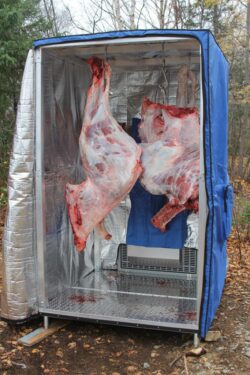Hot meat is rotten and spoiled meat. Unless you are cooking dinner, your wild game needs to stay cool. Once you have shot your wild game, the clock is running. Make sure that you have a plan and time before pulling the trigger.
Early antelope, elk, and deer seasons mean hot weather hunting. Temperatures over 80 degrees are common. Once the critter is down, your goal is to get them quickly to a cool walk in refrigerator or some other cooling area.
Start by opening the body cavity to release body heat. Large deer and elk mean skinning and quartering. Some hunters quarter with the skin on. This may be fine later in the cooler season. Hide on protects the meat from insects and dirt. It is best to use cotton meat sacks in hot seasons to do the same. Keeping insects off is also important. Cutting the hide, rather than skinning, also dulls the knife more quickly.
If the stomach was cut or damaged, take special care to minimize contamination. E Coli is a deadly bacterium that can cause major health issues. Digestive systems are full of bacteria so take your time. If you do have contaminated areas, wash, clean, and dry these areas.
The smaller sized meat will cool more quickly. Large bones will hold heat so deboning may be the best choice. Spread the meat onto a tarp or the hide.
Transport and get ready for the next step. COOL THE MEAT DOWN! This means a refrigerator, or a cool area. Shaded creek bottoms are great natural cool areas.
Ice chests loaded with ice is a good choice. Lay the meat on top of the ice with the drain open. You can also make a makeshift cooler using an elevated wood frame with ice in the bottom. I once built a cooler in the creek using this trick. Water temperature is usually cooler than air temps. I used rocks and wood logs to construct a dry box in the shaded creek. The tarp had no holes in it and made a dry, but cool space. I placed 4 elk legs, a bag of trimmed meat into the creek cooler. Another tarp on top held down with logs made the lid. We hunted another week before heading home. A thermometer said the box was a constant 50 degrees, especially at night.
Premium ice chests can hold ice for more than a week. Freeze ice in plastic milk jugs. They will also double as shower or drinking water. Block ice lasts longer than bag ice. You can cut small frozen water bottles up for ice in your drinks as needed.
Portable meat lockers are also a way to go. I have seen disassembled wooded boxes that you could walk in. A small air conditioner was added and run using a generator. The same idea can be made using utility trailers.
Native peoples would smoke, jerk, salt, or dry their meat. These old ways will also work well.
Montana Grant
For more Montana Grant, find him chillin at www.montanagrantfishing.com.